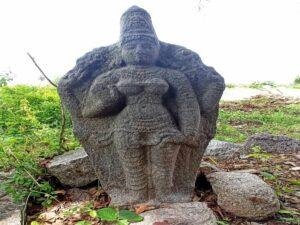
Why in News?
Archaeologists have recently discovered an eighth-century sculpture of Kotravai, an artifact from the Pallava period, near Ulundurpet, Tamil Nadu.
What implications arise from this discovery?
- Crafted from slab stone during the eighth century Pallava period, the sculpture signifies the artistic and cultural prowess of that era.
- The intricately detailed portrayal of items such as the chakkara, sword, bell, and abhaya mudra in its right hands, and the conch, bow, shield, and Uru Mudhra in its left hands, along with bangles adorning all hands, offers insight into the symbolism and craftsmanship of the time.
What are the significant details regarding the Pallava period?
- The Pallava Dynasty, which flourished in South India from around the 3rd to the 9th centuries AD, holds significant historical and cultural importance. Here’s a detailed overview of some key aspects of the Pallava period:
- Origin and Rise to Power:
- The Pallava Dynasty originated in the Tondaimandalam region of present-day Tamil Nadu. The earliest known Pallava ruler was Simhavarman I, who established his kingdom around Kanchipuram in the 3rd century AD. Over time, the Pallavas expanded their influence, eventually becoming a dominant force in South India.
- Architecture and Artistic Achievements:
- One of the most enduring legacies of the Pallava period is its contributions to architecture and art. The Pallavas were renowned for their patronage of Dravidian architecture, characterized by intricately carved temples and monolithic rock-cut structures. Notable examples include the Shore Temple at Mahabalipuram, the Kailasanatha Temple at Kanchipuram, and the rock-cut temples of Mamallapuram (Mahabalipuram). These monuments showcase exquisite craftsmanship and intricate sculptural details, reflecting the Pallavas’ artistic and cultural achievements.
- Maritime Trade and Diplomacy:
- The Pallavas were active participants in maritime trade, establishing trade links with Southeast Asia and beyond. Their strategic location along the Coromandel Coast facilitated trade with regions such as Sri Lanka, Southeast Asia, and even China. The Pallavas also engaged in diplomatic relations with neighboring kingdoms, forging alliances and expanding their sphere of influence through diplomacy and strategic marriages.
- Religious Patronage:
- Religion played a significant role in Pallava society, and the dynasty was known for its patronage of Hinduism and Buddhism. Many of the Pallava temples were dedicated to Hindu deities such as Shiva and Vishnu, with elaborate rituals and festivals held in their honor.
- Additionally, the Pallavas supported the spread of Buddhism, with several Buddhist monasteries and stupas built during their reign.
- Decline and Successor Kingdoms:
- By the 9th century AD, the Pallava Dynasty began to decline due to internal conflicts and external invasions. The rise of the Chola Dynasty and the emergence of the Rashtrakutas further weakened Pallava power. Eventually, the Cholas annexed much of the Pallava territory, marking the end of the Pallava Dynasty.
- However, the legacy of the Pallavas lived on through their architectural marvels and cultural contributions, which continue to inspire awe and admiration to this day.
Overall, the Pallava Dynasty played a pivotal role in shaping the cultural, religious, and architectural landscape of South India. Through their patronage of art, architecture, and religion, the Pallavas left an indelible mark on the history of the region, cementing their place as one of India’s most influential dynasties.
People also ask
1. What was the significance of the Pallava Dynasty in Indian history?
Ans: The Pallava Dynasty, ruling from the 3rd to the 9th centuries CE in South India, left an indelible mark on Indian history. Renowned for their patronage of art, literature, and architecture, the Pallavas contributed significantly to the cultural and architectural landscape of the region. They played a vital role in the spread of Hinduism, the development of Dravidian culture, and the expansion of maritime trade.
2. What were the major architectural achievements of the Pallava Dynasty?
Ans: The Pallava Dynasty is celebrated for its architectural marvels, including the Shore Temple in Mahabalipuram and the Kailasanathar Temple in Kanchipuram. These temples showcase the Pallavas’ mastery in temple construction and rock-cut architecture, featuring intricate carvings, monolithic sculptures, and elaborate gopurams. Additionally, the Pancha Rathas in Mahabalipuram stand as remarkable examples of Pallava monolithic rock-cut temples.
I don’t think the title of your article matches the content lol. Just kidding, mainly because I had some doubts after reading the article.
Can you be more specific about the content of your article? After reading it, I still have some doubts. Hope you can help me.
Thanks for sharing. I read many of your blog posts, cool, your blog is very good.